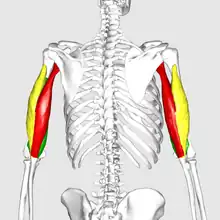
A push-down is a strength training exercise used for strengthening the triceps muscles in the back of the arm. This exercise can also be called a tricep push-down or a two armed standing tricep extension.
The exercise is completed by pushing an object downward against resistance. This exercise is an example of the primary function of the triceps, extension of the elbow joint.
There is multiple different variations to the push-down that will slightly do different things.
Rope push-down is a variation that involves connecting a rope attachment to a cable machine. While executing a rope push-down you have your palms facing in and internally rotate your arms while pushing down. This variation works all three parts of your tricep, but especially the lateral head (the yellow part of tricep on diagram).[1]

Straight bar push-down is a variation that involves connecting a straight bar attachment to a cable machine. In executing this variation, one will grab the straight bar attachment knuckles facing up and keep elbows tight while completing the extension. This variation targets the long-head of the tricep (the red part of tricep in diagram).[1] (Pictured to the right)
V-bar push-down is a combination of a rope push-down and a straight bar push-down. This variation calls for a V-bar attachment to be connected to a cable machine and executed by keeping elbows tight to the body while completing exercise. This variation targets all three parts of the tricep.
Push-downs can also be executed with resistance bands, alternating single armed, and with varying grips.
The tricep makes up the 70% of your arm's mass, and push-downs are a great way to exercise them.[2]
References
- 1 2 "What Does Each Tricep Attachment do?". Gym Plan. 2022-05-02. Retrieved 2023-04-19.
- ↑ Writer, Ben Winiger, Staff. "Muscles Explained: How to exercise your triceps". The Daily Beacon. Retrieved 2023-04-20.
{{cite web}}: CS1 maint: multiple names: authors list (link)